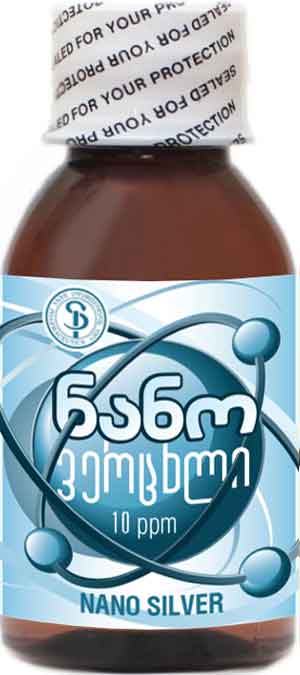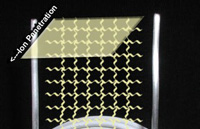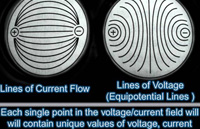Silver Iontophoresis
The Biological Delivery of Silver Ions via Electrical Injection
This document explores silver iontophoresis as an experimental means to address subdermal infections and otherwise untreatable skin conditions. By delivering silver ions through the skin barrier with minute amounts of electrical current, it is possible to address otherwise hard to reach locations and possibly speed tissue healing. This method should be approached very cautiously, as even small amounts of current can cause tissue damage.
Biological Terrain and Method of Delivery Can Limit Colloidal Silver Effectiveness
Silver, in its many forms, has been proven time and time again as one of the most effective substances in controlling and/or eradicating bacteria. In particular, "isolated" silver ions ( ions bound only with OH - ) have been demonstrated to be the most effective form of silver against infection causing organisms. However, in order for silver to be effective in-vivo, the silver particles and/or ions must reach the pathogens and be able to attach to special receptors located on bacterial cell walls ( silver ions ) or otherwise act in direct contact with any disease causing organisms ( silver particles ); the silver must be in an effective state and the biological terrain must be conducive to the entire process.
As an example, colloidal silver has been reported to be both effective and ineffective against sinus infections when the silver is used locally. Irrigating the sinuses with a proper colloidal silver can be an extremely effective solution, but only if the colloidal silver penetrates the mucus membranes and reaches the site of the infection. In challenging cases, the sinuses must be drained by repeatedly irrigating the nasal passageways.
A lung infection is another typical example. Lung infections respond very slowly to colloidal silver as used orally, if they respond at all. The colloidal silver, in such cases, never reaches the actual infection in concentrations great enough to be effective. However, colloidal silver used via a nebulizer is reported to be extremely effective against many different types of lung infections; the colloidal silver is delivered directly to the site of the infection where bacterial counts are rapidly reduced.
Skin infections and subdermal (beneath the skin) infections are among the greatest challenges to treat with any healing modality. Colloidal silver often achieves very satisfactory results where all else fails. Even so, the reports of effectiveness have often been mixed. In some cases, the response to treatment is very prompt. Other cases show only a slight improvement while still others show no improvement at all -- and all in situations where the illness causing organism is known to be susceptible to silver. This is especially the case with some forms of the herpes virus, and numerous types of acne infections, such as cystic acne and other cyst-based infections.
Electromedicine Offers a Possible Solution
Silver Injection via Electrolysis
Silver electrodes with a current limited power source implanted via a surgical procedure has proven effective in both the stimulation of tissue growth and the eradication of bacterial infections (see our page on Dr. Robert O. Becker's research)'. As Dr. Becker demonstrated, this treatment consistently eliminated bacteria within a 1/2 inch radius of the positive electrode when the electrodes were surgically implanted. While the dynamics of using a similar treatment on the surface of the skin are slightly different, there is great reason to believe that just such a method holds great promise in the successful treatment of stubborn skin infections.
When two silver electrodes are placed in contact with the skin of the body, and a small current is passed between the electrodes, the body itself completes the electrical circuit. As the electrons travel from the anode to the cathode, silver ions are drawn from the anode and thus deposited into the body along the lines of current flow. Due to the electrical nature of the process, the silver ions can penetrate the layers of the skin (a process known as iontophoresis -- the delivery of a drug by electrolysis).
|
|
Controlling the Current: Cell Healing or Cell Death?
As Dr. Robert O Becker demonstrated (see the previous page on Dr. Becker's work)', too much current delivered into the body can produce the illusion of accelerated healing while causing actual cell damage. To further complicate matters, current will not travel uniformly through body tissues, nor will all tissues respond in the same manner to the same level of current. In particular, injured areas of the body have less electrical resistance and are more susceptible to being damaged through the process. As Dr. Becker noted, when minute levels of current are delivered to healing tissues, the electrical resistance slowly increases as healing progresses. The right amount of current, measured at the site in question (and not necessarily on the surface of the skin), with the right electrodes (silver in particular) will accelerate healing, kill bacteria, and may alter a cell's' morphology to the point of dedifferentiation, including cancer cells. The wrong level of current will stimulate cancer growth (by as much as 300%), burn tissues, and cause direct electrolysis of body fluids resulting in the creation of gasses and other possible dangerous compounds.
We cannot speak from experience or with complete confidence as of yet concerning the ideal level of current to use for surface treatment of skin infections or subdermal infections. Our initial experiments demonstrated that currents as low as 0.3 milliamps could literally burn damaged tissue if the silver electrodes were placed directly to the skin. Of course, this level of current would not effect healthy tissues.
However, our limited experience demonstrated excellent results when using a conductive gel that saturated the entire area of treatment. Using a gel with an ideal ph level near 7.0 assists in the management of current flow, helping to prevent higher levels of current from traveling through damaged tissues.
We found that with a current level as "high" as 0.1 milliamps, each individual treatment should last from 5 to 15 seconds; "paths" of current are quickly established through the process, therefore the duration must be limited even if power is only cut for a brief moment.
To date, our experimentation has been very limited, pending a more versatile device design. However, our brief treatments with cystic acne clearly demonstrated that this method is worthy of serious consideration. Cysts caused by a bacterial infection begin to form beneath the skin, making early treatment nearly impossible. However, using this experimental method, if a forming cyst was treated soon enough upon formation, the infection could be eliminated, after which the body slowly eliminated the toxic byproducts without any form of skin eruption (in three test cases).
Cysts treated that were fully formed did not respond as favorably (in two test cases). This is not likely due to the bacteria itself, but rather the amount of fluid and toxic buildup already present in the tissues. In such cases, effectiveness is very difficult to measure, as the body's' natural healing process is the same with or without treatment. However, results in this case, from our brief experiments, would no doubt leave the sufferer disappointed in the end result.
The possibility of treating a wide variety of conditions is very promising, although any such treatment must, for reasons explained on this page and the one before, be viewed as highly experimental. Results are not instantaneous, and it should be realized that any accidental tissue damage can cause an infection to spread and/or delay healing.
As we gain more definitive data/information, we will expand this section of the website.
Reprinted from:
http://www.silvermedicine.org




